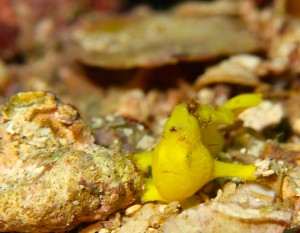Antennariidae – also known as Frogfish
When the bigger animals such as whale sharks and humpback whales leave or they are just not around, we turn our attention to other creatures in the ocean. Schools of barracuda, jacks and our beloved white-tips are still aplenty, but sometimes we also find some of the smaller ones hiding between the shells, rocks and coral. Undoubtedly, one of our favourites is the frogfish.
These fantastic creatures, are a type of anglerfish, that can be found in tropical and subtropical waters off the coasts of Africa, Asia, Australia, North America and Central America. We are lucky enough to have resident giant frogfish here in Coiba National Park.
Frogfish have a textured exterior, and unique colors, spines and bumps that have the ability to change to match their surroundings, making them the masters in camouflage! Unlike many animals that use camouflage as a defense from predators, frogfish mostly use their abilities to attract prey. Their size is between 1/8 inch to 22 inches.
Frogfish are carnivores and also cannibals. They eat fish, crustaceans and sometimes other frogfish! Their mouth can expand to 12 times its resting size, allowing them to catch all sorts of prey, bigger than themselves. Frogfish have a modified dorsal fin that has a retractable lure resembling a shrimp, which is used to attract their prey. If their lure is eaten or damaged it can be regenerated. Using its fishing rod and lure the frogfish will dangle the bait in front of its head. An unsuspecting passerby will see the lure and become excited, swimming towards a seemingly easy meal, where it gets eaten by the frogfish. Frogfish have the fastest strike speed of any animal on earth! As their prey comes to them, frogfish move only when they sense danger or need to mate.
Because frogfish lack a swim bladder, they use their modified pectoral fins to walk, or even gallop, across the seafloor. They also walk by gulping water with its massive mouth, then forcing the water through it’s gills allowing it to move. The body moves very little as the frogfish huffs and puffs its way through the water column.
 The female of these species lay eggs in the water and the male comes from behind to fertilize them. The abdomen of the female starts swelling as the egg absorbs water and this happens from 8 hours to several days before the laying of eggs. The male starts to approach the female two days before the spawning. The time of spawning is not known by scientists clearly, it may depend on the phase of the moon or a signal is possibly released by the female.
The female of these species lay eggs in the water and the male comes from behind to fertilize them. The abdomen of the female starts swelling as the egg absorbs water and this happens from 8 hours to several days before the laying of eggs. The male starts to approach the female two days before the spawning. The time of spawning is not known by scientists clearly, it may depend on the phase of the moon or a signal is possibly released by the female.
Once, Camilo´s sharp eyes spotted a minuscule yellow juvenile giant frog fish. No bigger that my fingernail this tiny miracle truly made our day. We managed to find it again and hope we will be able to track this little guy´s growth before it decides to leave or gets swallowed up.

